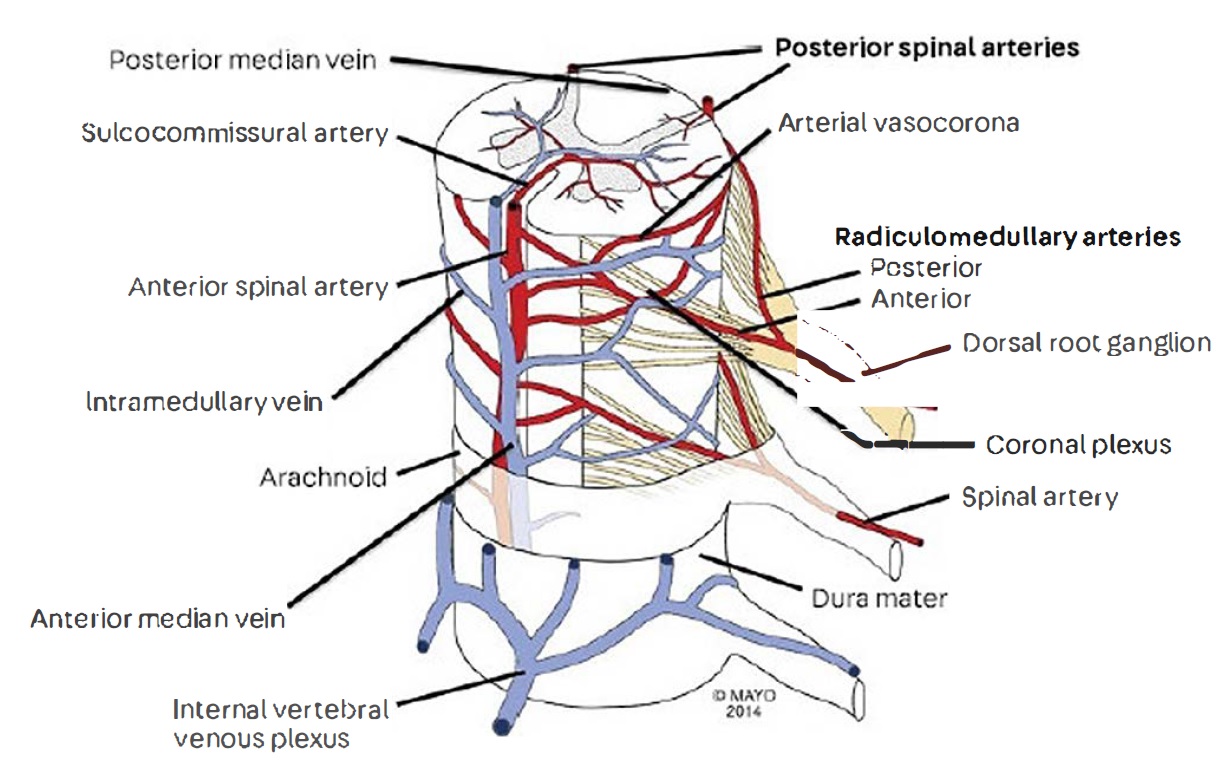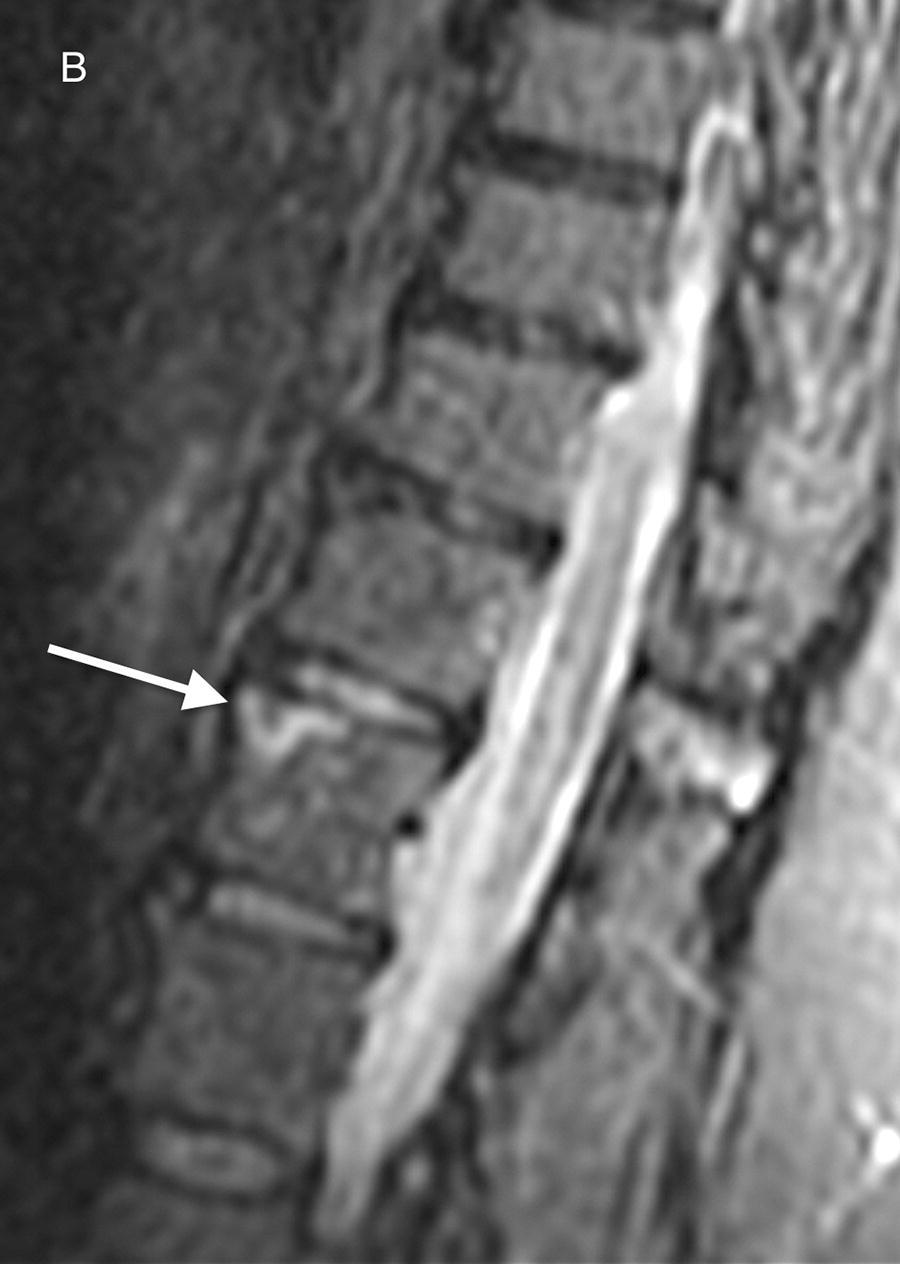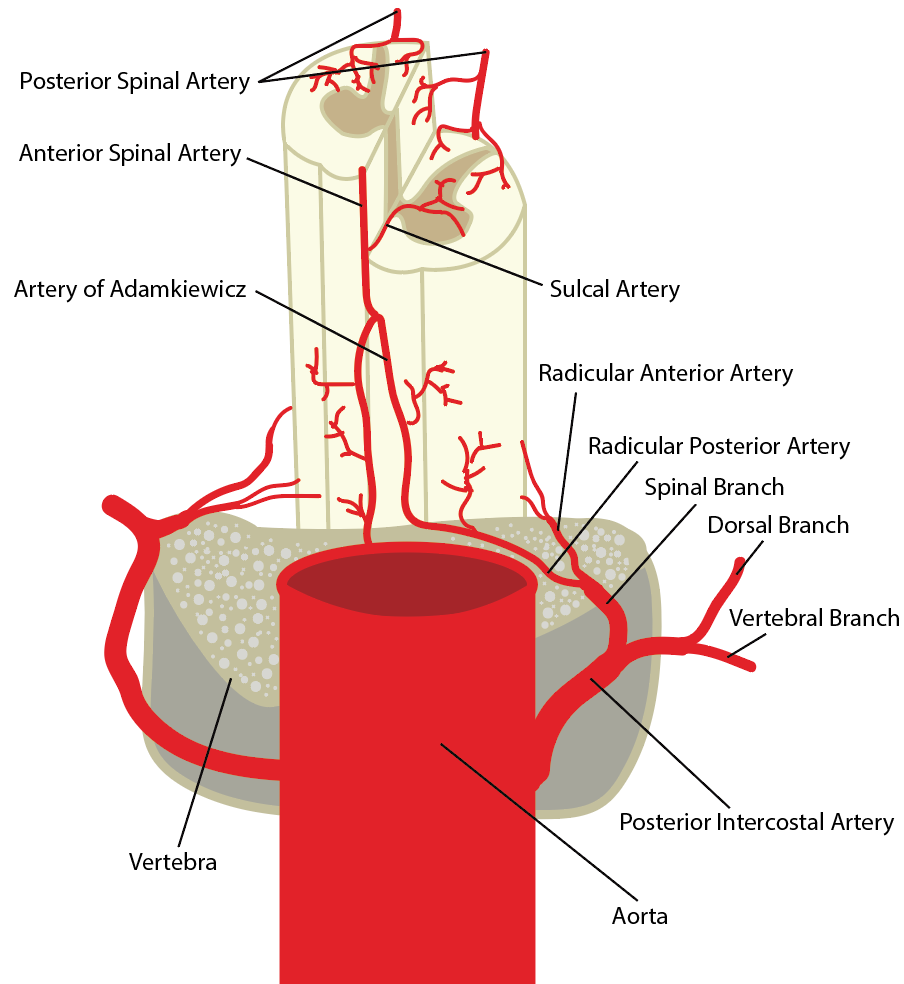[1]
Rubin MN, Rabinstein AA. Vascular diseases of the spinal cord. Neurologic clinics. 2013 Feb:31(1):153-81. doi: 10.1016/j.ncl.2012.09.004. Epub
[PubMed PMID: 23186899]
[3]
Kramer CL. Vascular Disorders of the Spinal Cord. Continuum (Minneapolis, Minn.). 2018 Apr:24(2, Spinal Cord Disorders):407-426. doi: 10.1212/CON.0000000000000595. Epub
[PubMed PMID: 29613893]
[4]
Crum B, Mokri B, Fulgham J. Spinal manifestations of vertebral artery dissection. Neurology. 2000 Jul 25:55(2):304-6
[PubMed PMID: 10908913]
[5]
Turnbull IM, Brieg A, Hassler O. Blood supply of cervical spinal cord in man. A microangiographic cadaver study. Journal of neurosurgery. 1966 Jun:24(6):951-65
[PubMed PMID: 5936484]
[6]
Martirosyan NL, Feuerstein JS, Theodore N, Cavalcanti DD, Spetzler RF, Preul MC. Blood supply and vascular reactivity of the spinal cord under normal and pathological conditions. Journal of neurosurgery. Spine. 2011 Sep:15(3):238-51. doi: 10.3171/2011.4.SPINE10543. Epub 2011 Jun 10
[PubMed PMID: 21663407]
[7]
Weidauer S, Nichtweiß M, Hattingen E, Berkefeld J. Spinal cord ischemia: aetiology, clinical syndromes and imaging features. Neuroradiology. 2015 Mar:57(3):241-57. doi: 10.1007/s00234-014-1464-6. Epub 2014 Nov 16
[PubMed PMID: 25398656]
[8]
Chakravorty BG. Arterial supply of the cervical spinal cord and its relation to the cervical myelopathy in spondylosis. Annals of the Royal College of Surgeons of England. 1969 Oct:45(4):232-51
[PubMed PMID: 4980920]
[9]
Cheshire WP, Santos CC, Massey EW, Howard JF Jr. Spinal cord infarction: etiology and outcome. Neurology. 1996 Aug:47(2):321-30
[PubMed PMID: 8757000]
[10]
Santillan A, Nacarino V, Greenberg E, Riina HA, Gobin YP, Patsalides A. Vascular anatomy of the spinal cord. Journal of neurointerventional surgery. 2012 Jan 1:4(1):67-74. doi: 10.1136/neurintsurg-2011-010018. Epub 2011 May 2
[PubMed PMID: 21990489]
[12]
Ahmann PA, Smith SA, Schwartz JF, Clark DB. Spinal cord infarction due to minor trauma in children. Neurology. 1975 Apr:25(4):301-7
[PubMed PMID: 1168316]
[13]
Vargas MI, Gariani J, Sztajzel R, Barnaure-Nachbar I, Delattre BM, Lovblad KO, Dietemann JL. Spinal cord ischemia: practical imaging tips, pearls, and pitfalls. AJNR. American journal of neuroradiology. 2015 May:36(5):825-30. doi: 10.3174/ajnr.A4118. Epub 2014 Oct 16
[PubMed PMID: 25324492]
[14]
Piffaretti G, Bonardelli S, Bellosta R, Mariscalco G, Lomazzi C, Tolenaar JL, Zanotti C, Guadrini C, Sarcina A, Castelli P, Trimarchi S. Spinal cord ischemia after simultaneous and sequential treatment of multilevel aortic disease. The Journal of thoracic and cardiovascular surgery. 2014 Oct:148(4):1435-1442.e1. doi: 10.1016/j.jtcvs.2014.02.062. Epub 2014 Feb 26
[PubMed PMID: 24698563]
[15]
Lynch DR, Dawson TM, Raps EC, Galetta SL. Risk factors for the neurologic complications associated with aortic aneurysms. Archives of neurology. 1992 Mar:49(3):284-8
[PubMed PMID: 1311168]
[16]
Robertson CE, Brown RD Jr, Wijdicks EF, Rabinstein AA. Recovery after spinal cord infarcts: long-term outcome in 115 patients. Neurology. 2012 Jan 10:78(2):114-21. doi: 10.1212/WNL.0b013e31823efc93. Epub 2011 Dec 28
[PubMed PMID: 22205760]
[17]
Zalewski NL, Rabinstein AA, Krecke KN, Brown RD Jr, Wijdicks EFM, Weinshenker BG, Kaufmann TJ, Morris JM, Aksamit AJ, Bartleson JD, Lanzino G, Blessing MM, Flanagan EP. Characteristics of Spontaneous Spinal Cord Infarction and Proposed Diagnostic Criteria. JAMA neurology. 2019 Jan 1:76(1):56-63. doi: 10.1001/jamaneurol.2018.2734. Epub
[PubMed PMID: 30264146]
[18]
Phillips OC, Ebner H, Nelson AT, Black MH. Neurologic complications following spinal anesthesia with lidocaine: a prospective review of 10,440 cases. Anesthesiology. 1969 Mar:30(3):284-9
[PubMed PMID: 4305091]
Level 3 (low-level) evidence
[19]
Kane RE. Neurologic deficits following epidural or spinal anesthesia. Anesthesia and analgesia. 1981 Mar:60(3):150-61
[PubMed PMID: 7011100]
[20]
MOSBERG WH Jr, VORIS HC, DUFFY J. Paraplegia as a complication of sympathectomy for hypertension. Annals of surgery. 1954 Mar:139(3):330-4
[PubMed PMID: 13149078]
[21]
HUGHES JT, MACINTYRE AG. SPINAL CORD INFARCTION OCCURRING DURING THORACO-LUMBAR SYMPATHECTOMY. Journal of neurology, neurosurgery, and psychiatry. 1963 Oct:26(5):418-21
[PubMed PMID: 14066633]
[22]
Kumral E, Polat F, Güllüoglu H, Uzunköprü C, Tuncel R, Alpaydın S. Spinal ischaemic stroke: clinical and radiological findings and short-term outcome. European journal of neurology. 2011 Feb:18(2):232-239. doi: 10.1111/j.1468-1331.2010.02994.x. Epub
[PubMed PMID: 20402756]
[23]
Rigney L, Cappelen-Smith C, Sebire D, Beran RG, Cordato D. Nontraumatic spinal cord ischaemic syndrome. Journal of clinical neuroscience : official journal of the Neurosurgical Society of Australasia. 2015 Oct:22(10):1544-9. doi: 10.1016/j.jocn.2015.03.037. Epub 2015 Jul 4
[PubMed PMID: 26154150]
[24]
Qureshi AI, Akbar MS, Czander E, Safdar K, Janssen RS, Frankel MR. Crack cocaine use and stroke in young patients. Neurology. 1997 Feb:48(2):341-5
[PubMed PMID: 9040718]
[25]
Mateen FJ, Monrad PA, Leep Hunderfund AN, Robertson CE, Sorenson EJ. Clinically suspected fibrocartilaginous embolism: clinical characteristics, treatments, and outcomes. European journal of neurology. 2011 Feb:18(2):218-225. doi: 10.1111/j.1468-1331.2010.03200.x. Epub 2010 Sep 6
[PubMed PMID: 20825469]
[26]
Novy J, Carruzzo A, Maeder P, Bogousslavsky J. Spinal cord ischemia: clinical and imaging patterns, pathogenesis, and outcomes in 27 patients. Archives of neurology. 2006 Aug:63(8):1113-20
[PubMed PMID: 16908737]
[27]
McGarvey ML, Cheung AT, Szeto W, Messe SR. Management of neurologic complications of thoracic aortic surgery. Journal of clinical neurophysiology : official publication of the American Electroencephalographic Society. 2007 Aug:24(4):336-43
[PubMed PMID: 17938602]
[28]
Gialdini G, Parikh NS, Chatterjee A, Lerario MP, Kamel H, Schneider DB, Navi BB, Murthy SB, Iadecola C, Merkler AE. Rates of Spinal Cord Infarction After Repair of Aortic Aneurysm or Dissection. Stroke. 2017 Aug:48(8):2073-2077. doi: 10.1161/STROKEAHA.117.017071. Epub 2017 Jun 27
[PubMed PMID: 28655811]
[30]
Foo CL, Swann M. Isolated paralysis of the serratus anterior. A report of 20 cases. The Journal of bone and joint surgery. British volume. 1983 Nov:65(5):552-6
[PubMed PMID: 6643557]
Level 3 (low-level) evidence
[31]
Yadav N, Pendharkar H, Kulkarni GB. Spinal Cord Infarction: Clinical and Radiological Features. Journal of stroke and cerebrovascular diseases : the official journal of National Stroke Association. 2018 Oct:27(10):2810-2821. doi: 10.1016/j.jstrokecerebrovasdis.2018.06.008. Epub 2018 Aug 6
[PubMed PMID: 30093205]
[32]
Etgen T, Höcherl C. Repeated early thrombolysis in cervical spinal cord ischemia. Journal of thrombosis and thrombolysis. 2016 Jul:42(1):142-5. doi: 10.1007/s11239-015-1332-1. Epub
[PubMed PMID: 26762860]
[33]
Mascalchi M, Cosottini M, Ferrito G, Salvi F, Nencini P, Quilici N. Posterior spinal artery infarct. AJNR. American journal of neuroradiology. 1998 Feb:19(2):361-3
[PubMed PMID: 9504495]
[34]
Kaplan SA, Chancellor MB, Blaivas JG. Bladder and sphincter behavior in patients with spinal cord lesions. The Journal of urology. 1991 Jul:146(1):113-7
[PubMed PMID: 2056568]
[35]
Banga PV, Oderich GS, Reis de Souza L, Hofer J, Cazares Gonzalez ML, Pulido JN, Cha S, Gloviczki P. Neuromonitoring, Cerebrospinal Fluid Drainage, and Selective Use of Iliofemoral Conduits to Minimize Risk of Spinal Cord Injury During Complex Endovascular Aortic Repair. Journal of endovascular therapy : an official journal of the International Society of Endovascular Specialists. 2016 Feb:23(1):139-49. doi: 10.1177/1526602815620898. Epub 2015 Dec 4
[PubMed PMID: 26637837]
[36]
Maynard FM Jr, Bracken MB, Creasey G, Ditunno JF Jr, Donovan WH, Ducker TB, Garber SL, Marino RJ, Stover SL, Tator CH, Waters RL, Wilberger JE, Young W. International Standards for Neurological and Functional Classification of Spinal Cord Injury. American Spinal Injury Association. Spinal cord. 1997 May:35(5):266-74
[PubMed PMID: 9160449]
[37]
Masson C, Pruvo JP, Meder JF, Cordonnier C, Touzé E, De La Sayette V, Giroud M, Mas JL, Leys D, Study Group on Spinal Cord Infarction of the French Neurovascular Society. Spinal cord infarction: clinical and magnetic resonance imaging findings and short term outcome. Journal of neurology, neurosurgery, and psychiatry. 2004 Oct:75(10):1431-5
[PubMed PMID: 15377691]
[38]
Thurnher MM, Bammer R. Diffusion-weighted MR imaging (DWI) in spinal cord ischemia. Neuroradiology. 2006 Nov:48(11):795-801
[PubMed PMID: 16977443]
[39]
Gempp E, Blatteau JE. Risk factors and treatment outcome in scuba divers with spinal cord decompression sickness. Journal of critical care. 2010 Jun:25(2):236-42. doi: 10.1016/j.jcrc.2009.05.011. Epub 2009 Aug 13
[PubMed PMID: 19682840]
[40]
Hamiko M, Endlich M, Krämer C, Probst C, Welz A, Wilhelm K, Schiller W. Dilatation of Vascular Prostheses in Ascending Aortic Position: A Long-Term Follow-Up Computed Tomography Study with Comparison of Different Measurement Methods. The Thoracic and cardiovascular surgeon. 2018 Apr:66(3):206-214. doi: 10.1055/s-0036-1597116. Epub 2016 Dec 13
[PubMed PMID: 27960216]
[41]
Iseli E, Cavigelli A, Dietz V, Curt A. Prognosis and recovery in ischaemic and traumatic spinal cord injury: clinical and electrophysiological evaluation. Journal of neurology, neurosurgery, and psychiatry. 1999 Nov:67(5):567-71
[PubMed PMID: 10519858]
[42]
Hanson SR, Romi F, Rekand T, Naess H. Long-term outcome after spinal cord infarctions. Acta neurologica Scandinavica. 2015 Apr:131(4):253-7. doi: 10.1111/ane.12343. Epub 2014 Oct 27
[PubMed PMID: 25346212]
[43]
Piatt JA, Nagata S, Zahl M, Li J, Rosenbluth JP. Problematic secondary health conditions among adults with spinal cord injury and its impact on social participation and daily life. The journal of spinal cord medicine. 2016 Nov:39(6):693-698
[PubMed PMID: 26833021]



